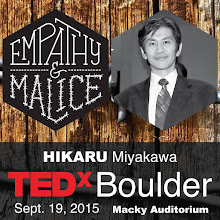Happy Thanksgiving to you all!
Many of you may
already know that "thank you" in Japanese is "Arigato", and it is
written as "有難う". It comes from "有難い /arigatai ," and it roughly means
that something which hardly (or hard to) exist - existing rarely
/有る事が難しい .
It might sound paradoxical, but when you reflect on it, it
is easily understandable.
It is to do with the attitude of gratitude and
not taking anything for granted. It implies the attitude that
everything is a miracle - hard to exist/to be.
There
is a legend of Buddha relating to this. (...although the content of this legend
varies.)
One day Buddha had asked one of his disciples what he felt
about being a human. Then Buddha spoke about the story about a blind
(or one eyed) sea turtle and a log with a small hole floating / drifting
freely and randomly on the ocean. This turtle swims all the time and
comes to the surface only once in 100 years. Buddha asked his disciple
whether this blind turtle could, by chance, "happen" to stick his head
into this hole in the log when he comes to the surface or not. The
disciple basically answered that it is nearly impossible, and even if it
can happen, it would take billions and trillions of years.
Then Buddha said, "To be born as human is even harder (rarer) than that." So, he taught his disciple(s) to be grateful to be born as human (or being reborn as human after being in the low, hellish levels/states of existence.)
Then Buddha said, "To be born as human is even harder (rarer) than that." So, he taught his disciple(s) to be grateful to be born as human (or being reborn as human after being in the low, hellish levels/states of existence.)
It is true that for us to be born, even without reflecting on how many sperms must die, many thing must happen intricately.
First of all, the entire universe had to be created!!!
Thus, it is miraculous.
Feeling of unquestionable gratitude for being born as human into the vast universe is the first step towards true happiness.
...and it is our DUTY to be filled with happiness from within and emit such happiness to the surroundings and back to the universe...







